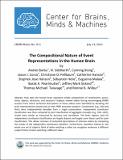The Compositional Nature of Event Representations in the Human Brain
Author(s)
Barbu, Andrei; Narayanaswamy, Siddharth; Xiong, Caiming; Corso, Jason J.; Fellbaum, Christiane D.; Hanson, Catherine; Hanson, Stephen Jose; Helie, Sebastien; Malaia, Evguenia; Pearlmutter, Barak A.; Siskind, Jeffrey Mark; Talavage, Thomas Michael; Wilbur, Ronnie B.; ... Show more Show less
DownloadCBMM-Memo-011.pdf (3.948Mb)
Terms of use
Metadata
Show full item recordAbstract
How does the human brain represent simple compositions of constituents: actors, verbs, objects, directions, and locations? Subjects viewed videos during neuroimaging (fMRI) sessions from which sentential descriptions of those videos were identified by decoding the brain representations based only on their fMRI activation patterns. Constituents (e.g., fold and shirt) were independently decoded from a single presentation. Independent constituent classification was then compared to joint classification of aggregate concepts (e.g., fold -shirt); results were similar as measured by accuracy and correlation. The brain regions used for independent constituent classification are largely disjoint and largely cover those used for joint classification. This allows recovery of sentential descriptions of stimulus videos by composing the results of the independent constituent classifiers. Furthermore, classifiers trained on the words one set of subjects think of when watching a video can recognize sentences a different subject thinks of when watching a different video.
Date issued
2014-07-14Publisher
Center for Brains, Minds and Machines (CBMM), arXiv
Citation
arXiv:1505.06670v1
Series/Report no.
CBMM Memo Series;011
Keywords
Computer Language, Linguistics, Language, Neuroscience, Vision and Language
Collections
The following license files are associated with this item: